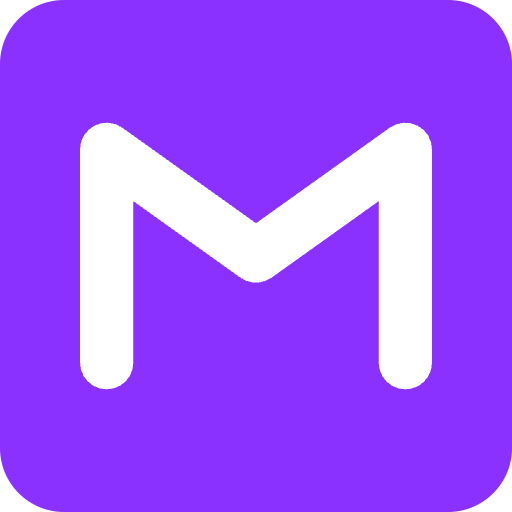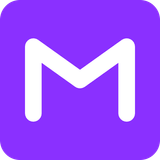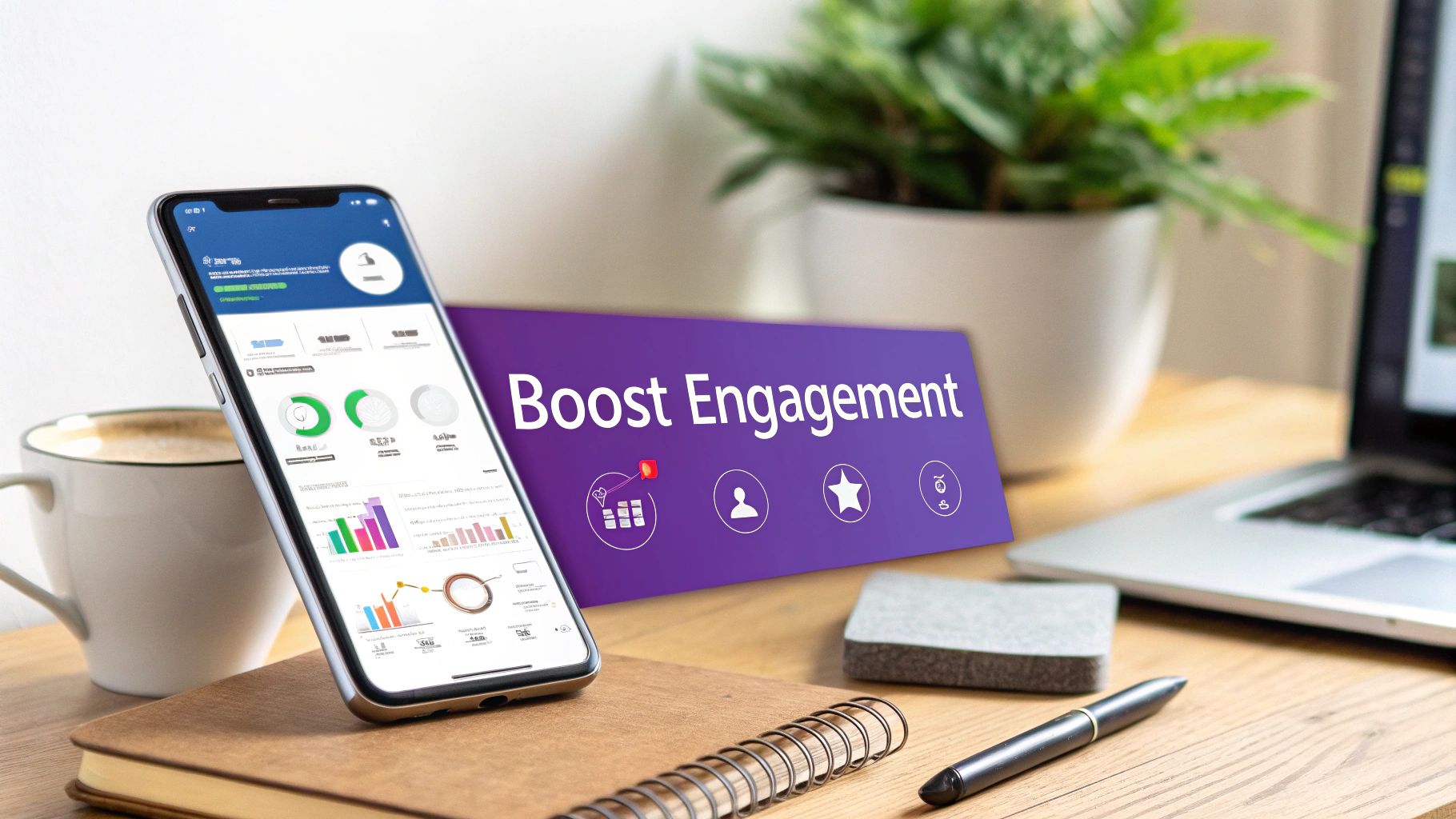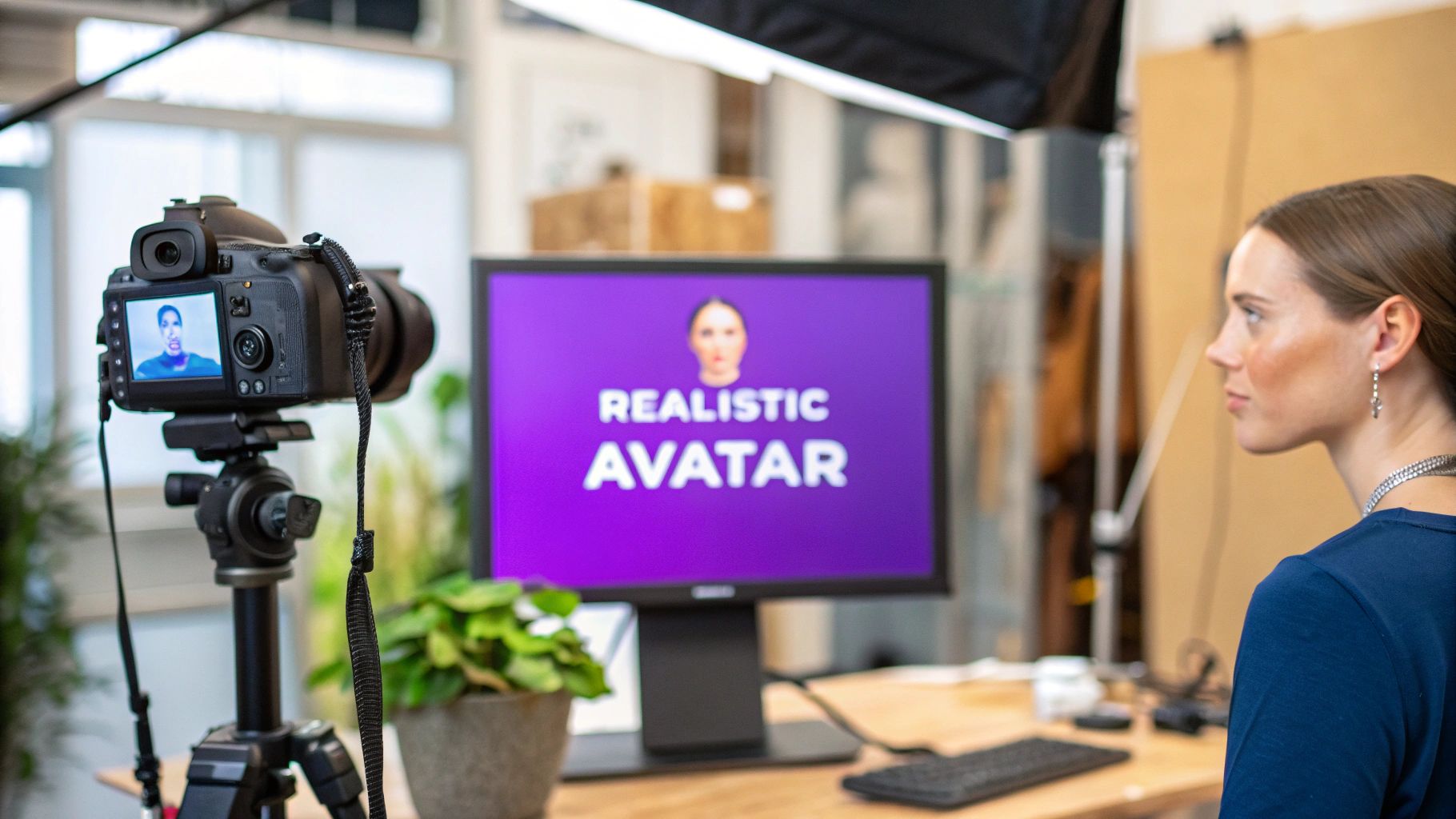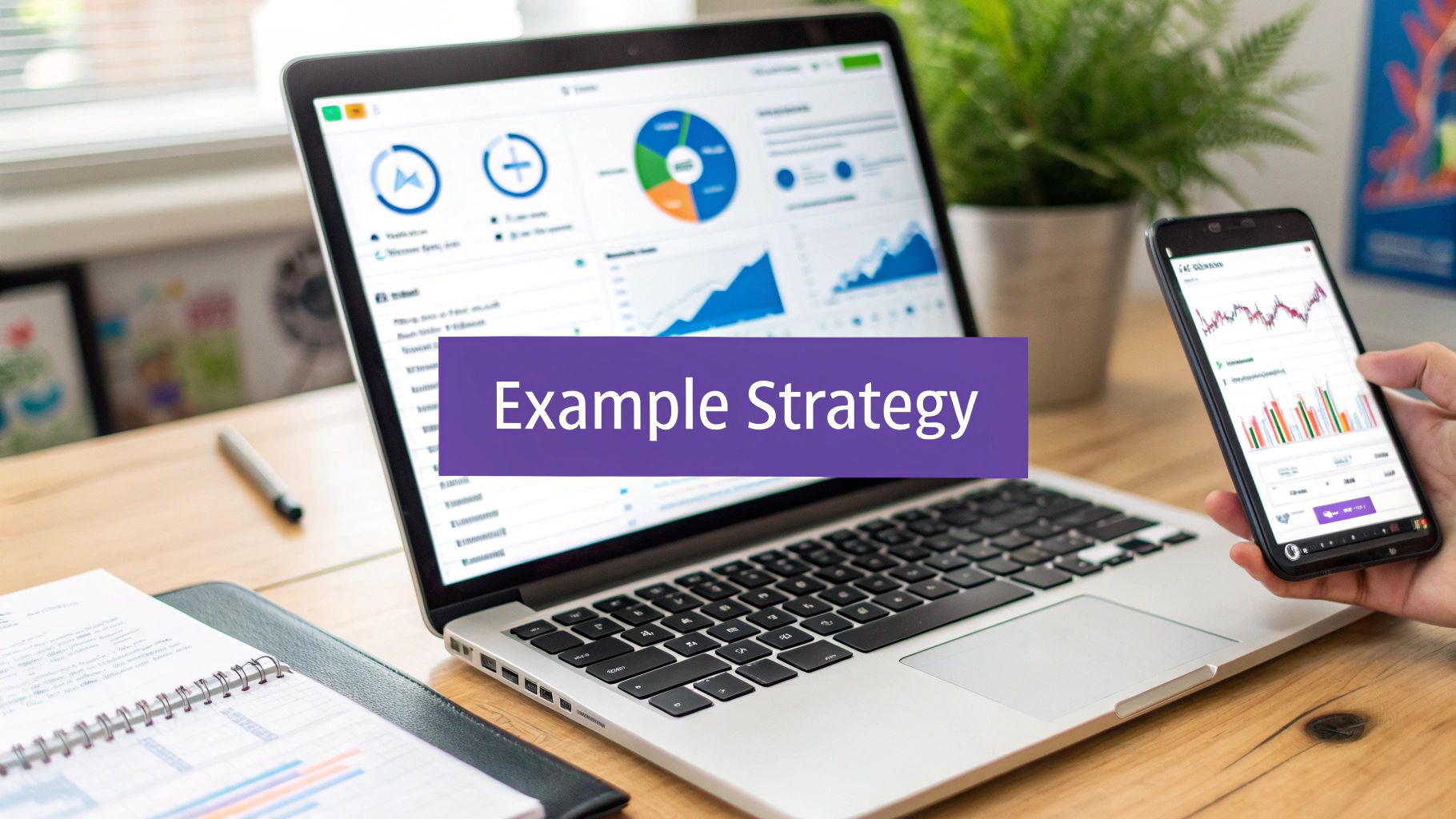How to Write Resume Summary: Tips to Land Interviews
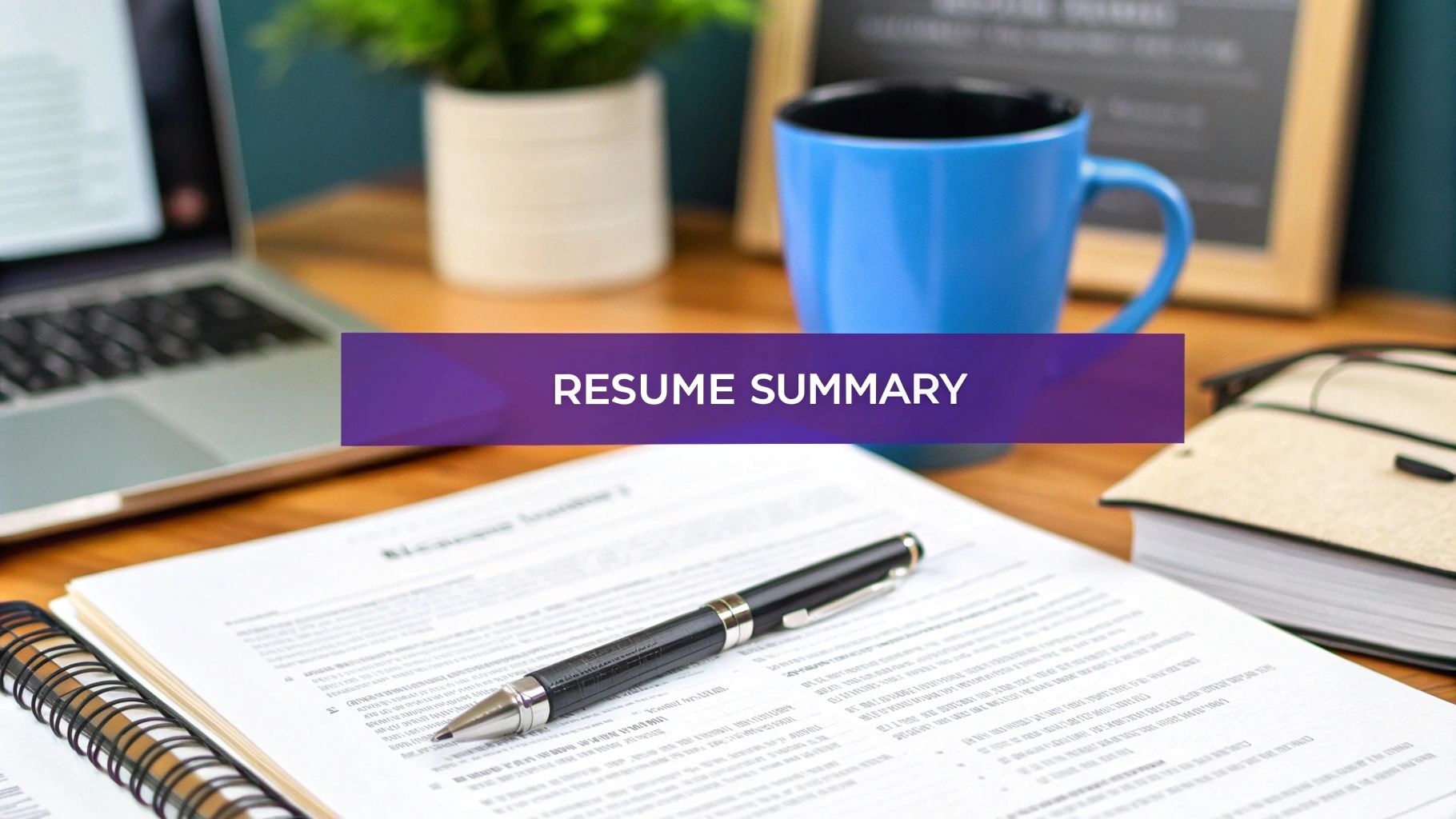
To land an interview, your resume summary needs to be a 3-5 line pitch that sits right at the top of your resume. It’s your chance to spotlight your most valuable skills and, more importantly, your quantifiable achievements.
This isn't your grandpa's "objective statement." Forget what you want from the company. The summary is all about the value you offer them. It’s a brief, powerful introduction and your best shot at making an immediate impact.
Your First Impression: The 6-Second Pitch

Think of your resume summary as a movie trailer for your career. In just a few seconds, it has to convince the hiring manager that the full feature—your entire resume—is worth their time. It's the very first thing they see, so it has to be compelling, concise, and packed with value.
The modern hiring process is a battle for attention, fought against both software and human nature. This is where a sharp, well-crafted summary gives you a significant edge.
Surviving the Digital Gatekeepers
Before a human ever sees your resume, it’s almost certainly going to be scanned by an Applicant Tracking System (ATS). These programs are digital gatekeepers, filtering candidates by searching for specific keywords straight from the job description. A weak or generic summary can get your application tossed before it even has a chance.
The growing reliance on AI makes this even more critical. By 2025, an estimated 83% of companies plan to use AI for resume reviews, a trend that underscores the need for a keyword-rich summary. This initial screening is purely robotic, making your word choice paramount.
Your resume summary has two jobs: first, get past the bots with the right keywords. Second, impress the human recruiter in the few seconds that follow. It must succeed at both to land you an interview.
Making Your Pitch Count
Crafting this pitch is about more than just listing skills; it's about building a narrative. It should be a concentrated dose of your professional identity.
It's a lot like learning how to write a script for video that grabs an audience from the start. Both formats demand you distill complex information into a short, powerful story that leaves a lasting impression.
Crafting Your Core Professional Narrative

If you want your resume summary to actually get read, you need to ditch the generic fluff. It's time to build a narrative that tells your unique professional story. This isn't just about listing skills; it's the art of self-promotion, where you learn to pinpoint your biggest strengths and present them with confidence.
Forget the fill-in-the-blank templates. Your goal is to build a compelling case for why you are the perfect fit. That means creating a powerful, authentic introduction that grabs a hiring manager's attention and doesn't let go. It's less about finding the right adjectives and more about backing them up with hard numbers that prove your worth.
Let's dig into how you can build this narrative from scratch.
Start With a Proven Formula
Even though your story is unique, a little structure goes a long way. Think of it as a framework, not a rigid rule, to make sure you’re hitting all the most critical points. I’ve found that a simple, three-part formula is incredibly effective and can be adapted for just about any role or industry.
- Your Title and Experience: Kick things off with your professional title and years of experience. This immediately tells the reader who you are.
- Key Skills and Specialization: Next, highlight two or three of your most relevant skills or areas of expertise that you know align with the job description.
- A Major Quantified Achievement: Finish strong. End with your single most impressive, quantifiable accomplishment to prove you deliver results.
This structure packs your summary with value, giving a quick snapshot of who you are, what you do, and the impact you make. I’ve seen this work for everyone from seasoned executives and career changers to recent grads.
The Power of Quantified Achievements
Vague claims are the death of a good resume summary. "Improved efficiency" is completely forgettable. But "reduced process time by 25%"? Now that’s a powerful statement that makes a hiring manager sit up and take notice. Numbers give them concrete proof of your skills and help them visualize the kind of impact you could have at their company.
Go through your work history and hunt for specific data points. Think in terms of percentages, dollar amounts, time saved, or units produced. This shift from describing responsibilities to showcasing results is what separates a good summary from a great one.
For instance, instead of writing "Managed social media accounts," try something like, "Grew organic social media engagement by 40% in six months." See the difference? The second version isn't just a task; it's a measurable success story.
Selecting Impactful Language
The words you choose are a huge deal. You want to use strong action verbs and specific adjectives that are a dead-on match for the role you’re targeting. Steer clear of clichés like "team player" or "hard-working"—let your achievements demonstrate those qualities for you. To make sure your summary is polished and professional, following essential business writing guidelines can really help sharpen your tone and clarity.
- Weak: Responsible for customer support.
- Strong: Resolved an average of 50+ customer tickets daily with a 95% satisfaction rating.
This approach helps you build a narrative that’s both authentic and incredibly persuasive. While a resume summary is short, many of the same storytelling principles apply to longer formats. You can get some great ideas by checking out various professional bio examples that also nail this concept.
Aligning Your Summary with Every Job Application

Submitting a one-size-fits-all resume summary is one of the fastest ways to get your application tossed aside. I've seen it happen countless times. Think of it this way: a generic summary is like giving the same birthday gift to everyone you know. It’s impersonal, shows you didn’t put in the effort, and rarely makes the right impression.
In a crowded job market, tailoring your summary for each role isn't just a "nice-to-have"—it's a must. That small investment of time shows a company you've done your homework and directly addresses what they're looking for. It’s your best shot at getting past the Applicant Tracking Systems (ATS) and into the hands of a real person.
Deconstructing the Job Description
Your roadmap for a killer summary is sitting right in front of you: the job description. This document is a checklist of the exact skills, qualifications, and values the employer wants. Your mission is to hold a mirror up to it, reflecting their needs with your experience.
Start by meticulously scanning the "Responsibilities" and "Qualifications" sections. Pull out the most important keywords and phrases. Don't just look for hard skills like "Python" or "Salesforce." You also need to spot the soft skills they emphasize, such as "strategic thinking," "cross-functional collaboration," or thriving in a "fast-paced environment."
Pro Tip: I always recommend creating a simple two-column list. On the left, list the key requirements from the job description. On the right, jot down your specific experiences or achievements that match each one. This visual map makes it so much easier to build your tailored summary.
Reframing Your Achievements to Match
Once you have your list of keywords and required skills, you can reframe your achievements to speak their language. The goal isn't to invent experience you don't have, but to shine a spotlight on the parts of your background that are most relevant to this specific role.
Let's walk through a real-world example. Imagine the job description heavily emphasizes "driving user engagement."
- Generic Statement: "Managed social media campaigns and grew followers."
- Tailored Statement: "Spearheaded targeted social media campaigns that drove a 35% increase in user engagement and content interaction."
See the difference? The tailored version directly uses the keyword "user engagement" and, more importantly, backs it up with a compelling metric. This strategy has become non-negotiable for job seekers. Customizing your resume to align with a role's unique requirements is key, especially since 48% of hiring managers now look for candidates who list a blend of both technical and soft skills.
This same principle of tailoring your professional story is just as crucial on other platforms. For instance, crafting a standout professional LinkedIn summary demands a similar approach of aligning your strengths with what your target audience—be it recruiters or clients—wants to see. Consistency across your professional brand is what sets you apart.
Resume Summary Examples That Actually Work
Theory is great, but nothing beats seeing real-world examples in action. Let's move past the abstract advice and break down some resume summaries that have actually helped people land interviews. We'll look at what makes them tick and why they grab a recruiter's attention.
The best summaries are short, sharp, and packed with results. They don't just list what you did; they show the impact you made. That’s how you make a lasting impression in those first few critical seconds.
Here's a quick visual that lays out the process for building a powerful summary from scratch.
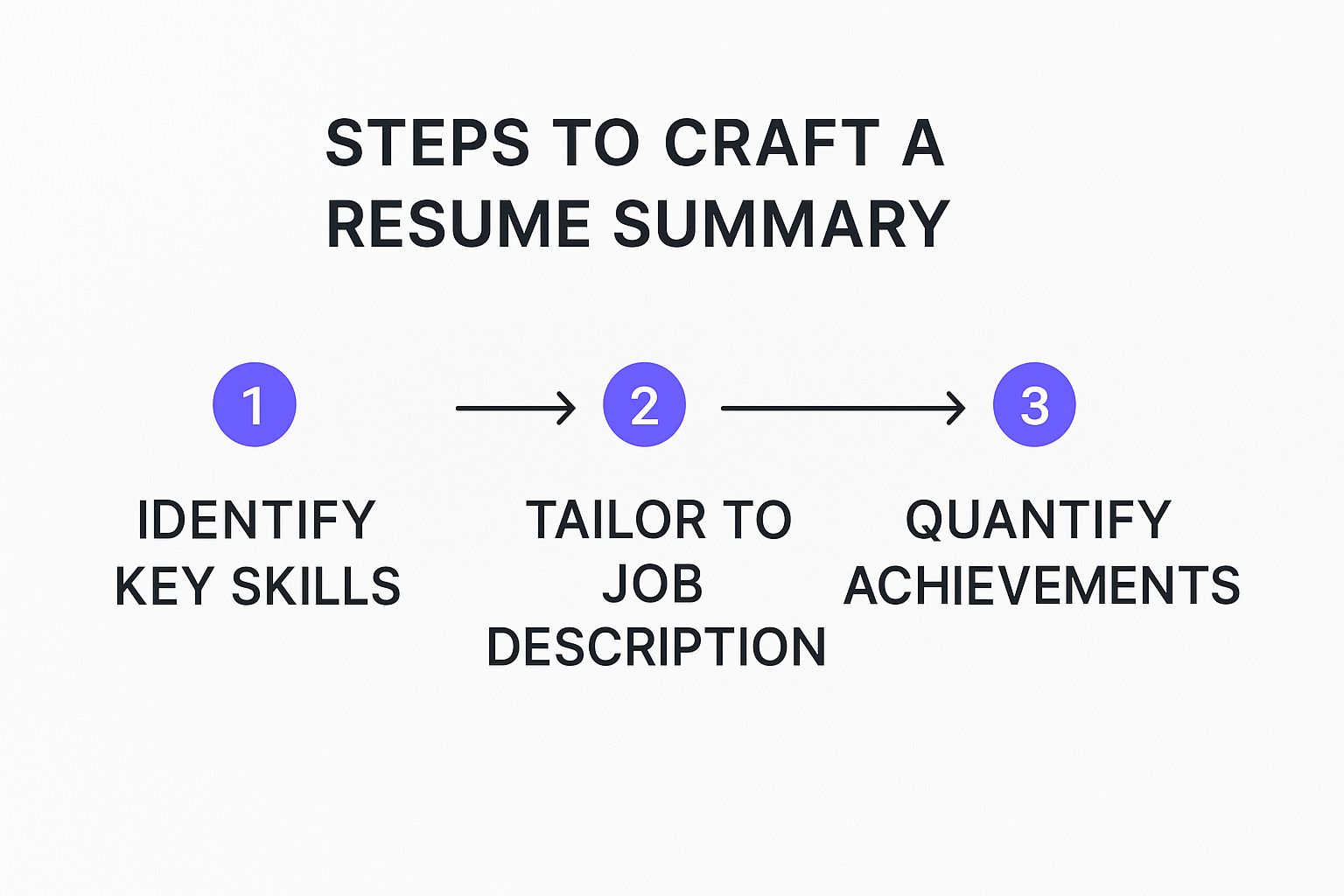
As you can see, it all starts with identifying your core strengths, customizing them for the job you want, and then backing it all up with cold, hard data.
Project Management Summary Example
A generic project manager summary often just lists duties, which is a surefire way to get overlooked. Let's take a bland summary and turn it into a compelling pitch.
- Before: Experienced project manager responsible for managing project timelines, budgets, and teams. Skilled in Agile methodologies and communication.
- After: PMP-certified Project Manager with 8+ years of experience leading cross-functional teams to deliver complex software projects on time and 15% under budget. Expert in Agile and Scrum frameworks, successfully increasing team velocity by 25% through improved sprint planning. Seeking to apply rigorous project controls to drive successful outcomes at a high-growth tech company.
Notice the difference? The "after" version immediately drops a key certification (PMP), quantifies budget and efficiency wins, and uses industry-specific language like "team velocity" that hiring managers in tech actually use.
Software Development Summary Example
In technical roles, you have to walk a fine line—blending specific tech skills with tangible business impact.
- Before: Software developer with experience in JavaScript and building web applications. A good team player and problem-solver.
- After: Full-Stack Software Developer with 5 years of experience specializing in React and Node.js. Proven ability to architect and build scalable web applications, contributing to a 30% improvement in load times for a high-traffic e-commerce platform. Passionate about writing clean, maintainable code and collaborating within an Agile team to ship high-quality features.
This revision gets specific. It names the tech stack (React, Node.js), directly connects the technical work to a key business metric (load times), and shows a commitment to modern dev practices like clean code and Agile.
Marketing Summary Example
For marketers, it’s all about showing creativity backed by data. You need to prove you can generate real, measurable results.
- Before: Marketing professional with experience in social media and content creation. Looking for a new opportunity.
- After: Data-driven Digital Marketing Manager with 6+ years of experience developing and executing strategies that boost brand awareness and lead generation. Spearheaded a content marketing initiative that increased organic traffic by 75% in 12 months and grew the marketing-qualified lead (MQL) pipeline by 40%. Proficient in SEO, SEM, and HubSpot.
The winning version uses strong action verbs ("spearheaded"), provides impressive, specific metrics (75% traffic increase, 40% MQL growth), and lists relevant tools and specializations that recruiters scan for.
Key Takeaway: The strongest summaries translate your responsibilities into tangible achievements. They answer the employer's unspoken question: "What results can this person deliver for us?"
These principles aren't just for your resume. A strong professional brand is consistent everywhere. You can adapt these same strategies by reviewing some high-impact LinkedIn profile summary examples to make sure your story is powerful and cohesive across all platforms.
Your resume summary is the headline for your professional story, but it’s just the start. A truly powerful personal brand doesn't just live on a document—it extends across your entire online presence. This creates a consistent, compelling narrative that recruiters can actually trust.
Let's be real: authenticity is everything in today's hiring game. Recruiters and hiring managers don't stop at your resume. They're digging into your online footprint to get a feel for who you are and to see if the story you're telling holds up. A disconnect between what your resume says and what your LinkedIn profile shows can be an instant red flag.
Aligning Your Digital Identity
This consistency is your secret weapon for building credibility. Your LinkedIn headline and "About" section should echo the same core message you crafted for your resume summary. Think of them as different formats for the same story, each tweaked for the platform but unified in its message.
For instance, if your resume summary shouts about your skill in "driving B2B sales growth through strategic partnerships," your LinkedIn headline should reflect that. Something punchy like "B2B Sales Leader | Driving Revenue Through Strategic Alliances" creates an immediate, clear connection. Your LinkedIn "About" section is the perfect place to expand on those quantified achievements from your resume, adding more color and personality.
A resume summary is a key piece of your professional identity. For a bigger picture on how to build a strong personal brand on LinkedIn, which hinges on a concise summary of your story, this guide is a great resource.
The Proof Is in the Profile
This isn't just a "nice-to-have" anymore. Employers are actively using social media to vet candidates, making this alignment more critical than ever. In fact, research shows that a staggering 67% of employers use social media to screen applicants, and what they're looking for is that authentic, consistent brand.
Despite this, a surprisingly small fraction—fewer than 1% of resumes—include links to social profiles. That's a huge missed opportunity to take control of your narrative and show them what you're all about.
Your resume tells a recruiter what you’ve done. Your aligned online presence shows them who you are. A cohesive brand story across all platforms transforms you from a list of qualifications into a memorable, trustworthy candidate.
Ultimately, this unified approach is what builds trust and makes you stand out from the crowd. To get your LinkedIn presence just as strong as your resume, check out our guide on how to optimize your LinkedIn profile. It's packed with actionable steps to help you build a compelling and cohesive brand online.
Common Questions About Resume Summaries
When you're fine-tuning your resume summary, a few common questions always seem to pop up. Getting these details right can be the difference between a resume that gets a second look and one that gets tossed aside. Let's walk through some of the most frequent sticking points I see, so you can write your summary with confidence.
Think of this as moving from uncertainty to a clear, strategic game plan.
Summary vs. Objective: What’s the Difference?
This is probably the biggest point of confusion, and it’s a critical one to understand.
A resume objective is an old-school approach that focuses on what you want from a job (e.g., "Seeking a challenging role in marketing..."). A resume summary, on the other hand, is the modern, far more effective choice. It highlights the value you bring to the table for the employer.
It’s a quick, powerful pitch about your skills and wins, framed around what they need. In short, a summary is about them, not you. Making that mental shift is everything when it comes to grabbing a recruiter’s attention.
How Long Should a Resume Summary Be?
Brevity is your best friend here. Aim for two to four sentences, which usually comes out to about three to five lines of text on the page.
Remember, recruiters are scanning resumes in just a few seconds. A short, punchy summary has a much better shot at being fully read and making an impact than a dense, long-winded paragraph. Get straight to the point and lead with your most impressive information.
Pro Tip: Write your summary last. After you've detailed your work experience and achievements, it's so much easier to pull out the highlights and weave them into a compelling summary. You'll have all the best material right in front of you.
Should I Use First or Third Person?
This one is a subtle but important convention. The professional standard is to write in the first person but to drop the pronouns like "I," "my," or "me." This approach sounds direct and confident without coming across as too informal.
- Instead of: "I am an experienced project manager who has led several teams."
- Write this: "Experienced project manager with a record of leading high-performing teams."
See the difference? It frames your skills as factual headlines rather than personal stories, which is exactly the professional tone you want to strike.
Do I Still Need a Summary as a Recent Graduate?
Absolutely. For recent grads or career changers with limited experience, a resume summary is even more valuable. It’s your chance to frame your potential and tell the hiring manager where to focus.
Instead of a long work history, you can shine a light on:
- Relevant academic achievements and key coursework
- Skills you picked up during internships or major projects
- Specific software you know or technical abilities you have
- A clear, demonstrated passion for the industry
This shows an employer what you're capable of from day one, even if you don't have a long list of previous jobs. It’s also a fantastic way to start building your professional brand—a story that should be consistent everywhere, from your resume to your online profiles. Speaking of which, a strong online presence is a huge asset. Learning how to increase LinkedIn connections is a great way to boost your visibility and supplement your resume.
Ready to create a professional presence that gets noticed? MakerBox uses AI to generate optimized bios, profile photos, and social media content that will elevate your brand across all platforms. Stop guessing and start standing out. Get your professional rebrand with MakerBox today!
